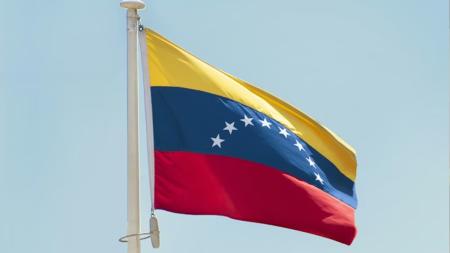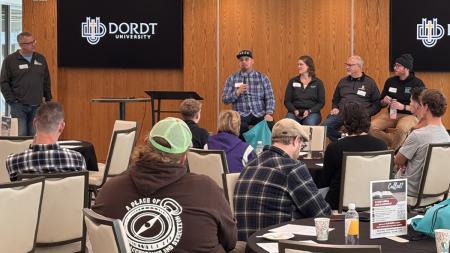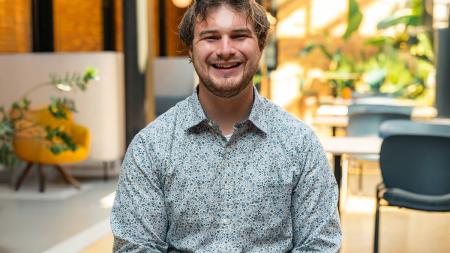The ‘Charles Wesley’ of South Sudan

This story was first published by the Calvin Institute of Christian Worship and is shared with permission.
By all accounts, Mary Aluel Garang* has never sought the limelight. She was born into a traditional cattle-herding Dinka family in about 1966 in what is now Jonglei, a state in South Sudan. The Dinka are South Sudan's largest people group. Garang became a Christian in 1984, early in the Second Sudanese Civil War. Soon afterward she began composing theologically rich songs in the Dinka Bor dialect.
She kept writing despite having to relocate several times for safety and for education before South Sudan gained independence in 2011. Throughout her life, whether focusing on theological education or women's development, she has continued to write hymn texts.
Anglican/Episcopal and other Sudanese Christians around the world still sing Garang's hymns because her words help them locate themselves within the story of God. Singing her songs helps them make sense of the conflicts that continue to displace, maim, and kill people in South Sudan. In fact, scholars have described Garang as "a gifted natural theologian" and "the Charles Wesley of the church of Sudan."
From the Margins
While many books about Sudanese Christianity mention Garang or use phrases from her songs as book or chapter titles, two books by North American Episcopalians help to provide a picture of her life.
"Mary . . . is from a family with a tradition of traditional compositions. Her language and idioms are extremely rich, deeply rooted in the rural language of her . . . people," Marc R. Nikkel writes in Dinka Christianity: The Origins and Development of Christianity among the Dinka of Sudan with Special Reference to the Songs of Dinka Christians. Nikkel was an American Episcopal priest who worked among the Dinka for twenty years. He translated many songs by Garang and other Dinka Christians into English.
In traditional pre-Christian Dinka culture, girls and women rarely created songs. They had to stay silent and seated during family discussions. They were valued mainly for growing millet and vegetables during the rainy season, earning a high bride price in cows, and producing sons who could increase herd sizes. The Anglican missionaries who came from the United Kingdom in 1899 to educate a cadre of indigenous Dinka evangelists did not invite girls to study in mission schools.
Somehow, Garang briefly attended school as a young girl in Malakal, a city along the banks of the White Nile. But she was "taken, snatched from the town, to be taken home. At that time, the Dinka say, 'Our girls cannot be in towns. We need our girls to be in the cattle camps,'" she told Jesse A. Zink in 2013 while he was doing extensive fieldwork to write Christianity and Catastrophe in South Sudan: Civil War, Migration, and the Rise of Dinka Anglicanism. Zink, an Anglican/Episcopal priest and author, is now principal of Montreal Diocesan Theological College in Montreal, Que.
The Dinka remain proud of their legendary cattle-herding culture and wrestling prowess. They orally transmit ancestral values through songs and sayings. But even during Garang’s childhood, several factors—unusual flooding, widespread cattle disease, and the First Sudanese Civil War (1955-72)—forced young men to leave home. Many learned to read and write in Dinka and in English and became Anglican Christians. Zink explains that Dinka culture stayed focused on cattle camps, villages, and shamans of local divinities called jok (singular) or jak(plural). Christianity remained a minority religion, something for the young, urban, educated, and elite. But the Second Sudanese Civil War (1983-2005) changed all that.
Displacement Creates Space for Women
The roots of Sudanese civil conflict included the aftermath of British colonialism; ethnoreligious conflicts between the Arab Muslim north and animist/Christian south; disputes over water, fertile land, and oil deposits; and political and intertribal rivalry.
The Second Civil War displaced people from towns and cities back to villages and cattle camps. They brought their faith and songs with them. Garang learned about Christianity from young people who moved to her village from the market town of Bor, on the east bank of the White Nile River. Zink writes in a blog post that this pattern of urban Christians’ bringing the faith to rural people was repeated all along both riverbanks, from Juba north to Khartoum.
When Garang converted and was baptized in 1984, "she was divorced, and her only child had died. This put her in an unusual and almost powerless position in Dinka society. Today, however, she is widely recognized in the Dinka church and beyond," Zink writes in Christianity and Catastrophe. That so many Dinka Bor people became Anglican during the Second Civil War is due partly to a decision by Bishop Nathaniel Garang Anyieth (no relation to Garang) to stop requiring literacy as a condition of baptism.
Zink explains in his book that the Church Missionary Society (CMS) had for generations required baptismal candidates to study for a year or more until they could prove they knew enough about Christianity. Growing up in an oral culture, the Dinka were very good at memorizing, and missionaries suspected that they were "cheating" by simply memorizing rather than reading the necessary passages and answers. They worried that baptized Christians wouldn't be able to deepen their faith without literacy.
But for five years during the Second Civil War, the people in the Bor region were cut off from the rest of the Anglican Church. Bishop Nathaniel was the only bishop in Bor, and thousands of Dinka Bor wanted to switch allegiance to a God more effective than their local jak. So the bishop decided to baptize first and train and catechize later.
All these changes created a kairos moment for Dinka women to meet and encourage each other through worship and church meetings and to share learning in their preferred cultural way: singing.
Songs from Scripture
Like many other Christians around the world, many Dinka Anglicans began learning the Bible and theology through songs. Meditating on Scripture inspired Garang to compose hymn texts. In 1985, the year after her conversion, she wrote two songs that quickly spread widely, according to Nikkel.
The first, "Death Has Come," spoke to people as warring groups stole their cattle, burned their homes, destroyed jak shrines, raped and killed their relatives, and forced them to flee. When this song was published in the first hymnal edited by Dinka Anglicans, the editors gave John 11:25-27 as the scriptural reference. "Death Has Come" is the first song that Garang sings on what's described as "Aluel Garang Anyuon's Classic Album." That's according to Luke Bol Majak, the current elected parish secretary of St. Luke's Church, Ngumo-Dinka congregation, a diaspora Episcopal Church of South Sudan congregation in metro Nairobi, Kenya.
The first of four long verses begins with the words "Death has come to reveal the faith." The hymn gives voice to suffering and pleas, as in verse 3: "God, do not make us orphans / of the earth. / Look back upon us, / O Creator of humankind. / Evil is in conflict with us." The final verse adds, "Let us encourage our hearts / in the hope of God, / who once breathed wei [breath and life] / into the human body. / His ears are open to prayers: / the Creator of humankind is watching."
The second early song that became a favorite was "God Has Come among Us Slowly." Garang wrote this text and "Death Has Come" in Kongor, which had a brief flurry of Christian revival in the late 1940s and early 1950s, according to Zink's book. Meanwhile, other people groups in southern Sudan responded far more enthusiastically to Christian missionaries than the Dinka did, says Zink.
The first of five verses begins this way: "God has come among us slowly, / and we didn't realise it. / He stands nearby, behind our hearts, / shining his pure light upon us." The song explains that God, not jak, created all people and all things, even the insects. It asks for the Lord's power and "guiding Spirit of truth" to reach everyone, and it muses, "We receive salvation slowly, slowly, / all of us together, with no one left behind [v. 2]. . . . Gradually, gradually it will succeed, / until the day when it will be grasped / by the Dinka who sacrifice at shrines [v. 3]."
"Natural Theologian"
What are now Sudan and South Sudan overlap the area known in ancient times as Nubia, Kush, or Cush. Early CMS missionaries drew parallels between biblical references to Cush and the Dinka people, especially Isaiah 18, which mentions tall, smooth-skinned warriors in a land divided by rivers.
That chapter wasn't included in the hundred Old Testament passages that Archibald Shaw and other CMS missionaries translated into Dinka before World War II. But the first British edition of the Good News Bible gave Isaiah 18 the chapter heading "God Will Punish Sudan." Nikkel, Zink, and other scholars explain that Isaiah 18 became a keystone passage to help the Dinka understand their suffering. (Compare Isaiah 18 versions in this Zink presentation, slide 10.)
Many Dinka Christians believed Isaiah 18 foretold that great suffering would purify the Dinka to reject the jak and return to Nhialic, the Creator God known already in their traditional religion. Then God would bless them, and they'd gain national independence (a "signal raised on a mountain," v. 3). Garang’s most famous song, "Let Us Give Thanks" (also known as "Day of Devastation, Day of Contentment"), expresses that confidence and hope. (Listen to the song in Dinka.)
Nikkel says Garang composed "Let Us Give Thanks" after being displaced yet again, first after the November 1991 Bor Massacre and then in July 1992 after government forces captured the town of Torit, near the Ugandan border. The song frames devastation as part of God's plan: "Evil is departing and holiness is advancing; / these are the things that shake the earth" (v. 1). It calls people to "remove hatred and the stubbornness of hearts bound by sins" (v. 3), to "do what you are able to do / according to the gift which / has been given you" (chorus), and to "let the name of God be praised" (v. 6).
Nikkel describes Garang as "perhaps the finest composer of her era, certainly among the Bor Dinka, and likely the most gifted 'natural theologian.'" He wrote that when the archbishop of Canterbury visited Nimule in southern Sudan in early 1993, the people sang "Let Us Give Thanks" after each of his addresses.
In the February 2017 issue of Sudan Studies (pp. 12–21), Zink analyzes the Bung de Diet ke Duor (BDD, or Book of New Songs of Worship), a Dinka-language hymnal created by members of the Diocese of Bor of the Episcopal Church of the Sudan in the 1990s. The BDD songs are divided into "choruses" (496) and "long hymns" (164). Forty-three percent of its songs were written by women. Of the nineteen women composers, Garang contributed nine long hymns—the most of any composer in the BDD. "It is these hymns that have done so much to shape the theology of Dinka Christianity and which are sung with such fervour by Dinka Christians today. . . . Although the hymnal was written in the Bor dialect, it was used throughout the Dinka Anglican church," Zink writes.
Still Singing for Peace
"I think I met the Charles Wesley of the church of Sudan," Jason Byasse wrote in a Faith & Leadership blog post in 2010. "Just as Charles’ hymns powered the Methodist movement across the British Isles, the Americas, and now the Global South, so too did Garang’s songs power a revival in the Episcopal Church of Sudan (ECS), helping to bring in millions of members during that country’s brutal two-decade long civil war." By then, Garang had managed to get five years of theological education in Kenya, "as much as any leader I met in the ECS," Byasse reported.
In the 2010s, Garang’s work focused on girls and women. As director of a church and development office in gender equity, she convinced many parents in the Bor Diocese to send their daughters to school. As women's ministry director for Partners in Compassionate Care, she taught women how to read, use a solar-powered "talking Bible," access healthcare, start businesses, and work for peace. She has continued to teach and occasionally write hymns. She is married to Daniel Chagai Gak Deng, an ECSS priest, and lives in Juba, the capital of South Sudan.
In South Sudan, as in other places, identity politics are polarizing churches and nations. Yet Garang has remained known for focusing on what unites people.
"In most countries around the world, politics has managed to overshadow faith. Once you appeal to people's emotions politically, they are likely to react. The people of South Sudan have been divided along tribal lines and made to believe that true liberation for them is attached to tribal identity. Not all are able to appreciate that Christian faith binds them to people with different tribes and politics," Lual Mayen-Adiit said in a February 2022 Zoom call. He coadministrates the St. Luke's Church webpage and is head of the Jol Wo Lieech(“Look back on us, God”) hymn-teaching branch for Nairobi, Kenya.
"Mary Aluel comes to St. Luke's whenever she is in Nairobi," Lual Mayen-Adiit said. "She still writes hymns and songs. She is as strong in faith as ever. Some people write songs to be creative, as if writing a song does God a favor. Mary Aluel's songs flow out of prayer, and her themes transcend generations. One of her recent songs talks about forgiveness. It asks us to displace the spirits of hate and revenge and move forward."
* A note on names: This hymn writer has been variously described as Mary Aluel, Mary Alueel, or some combination of Mary Aluel Garang (her father's name) Nongdit (nickname of great respect meaning "great feather") Anyuon (her paternal grandfather's name).


